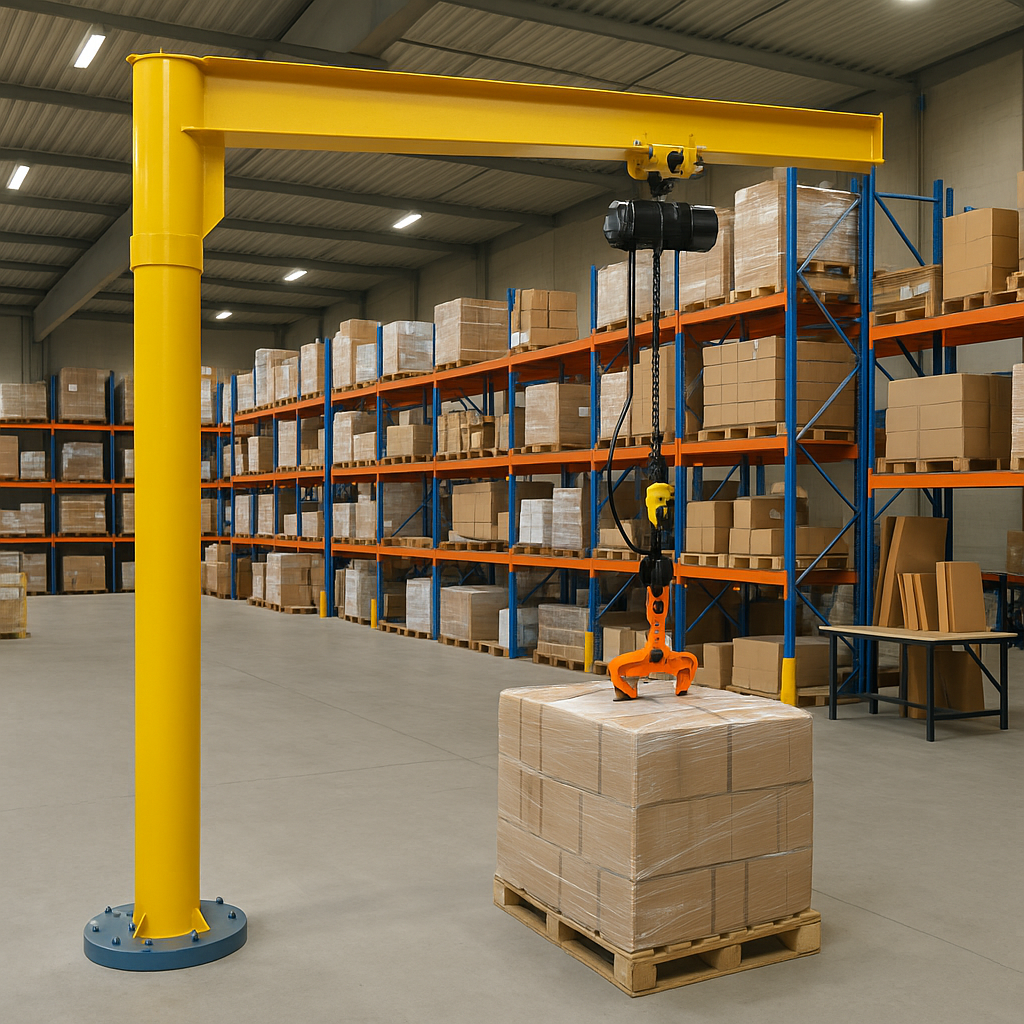Efficiency and safety are top priorities in warehouse and logistics environments. From heavy pallet handling to precision placement at packing stations, the jib crane plays a vital role in streamlining daily operations. Its compact design, flexibility, and strength make it a go-to lifting solution for localized material movement—particularly where overhead cranes are impractical or too large.
In this article, we’ll explore how jib crane applications improve productivity in warehousing and logistics, which crane types work best, and how businesses benefit from implementing them correctly.
🔍 For a broader look at usage across sectors, check Jib Crane Applications: Where and How They’re Used Most
Table of Contents
ToggleWhat Makes the Jib Crane Ideal for Warehousing?
A jib crane is a lifting system with a horizontal arm (jib or boom) that supports a hoist. It can rotate (typically 180°–360°) and is either mounted to the floor, a wall, a column, or a ceiling mast. In warehouse operations—where repetitive, short-range lifting is constant—this flexibility is critical.
Key Benefits:
- Frees up forklift resources
- Reduces manual lifting injuries
- Increases pick-and-pack speed
- Operates in tight spaces where large cranes can’t
Types of Jib Cranes in Warehouse Applications
Each type of jib crane has unique features suited to specific warehouse layouts or workflow needs.
1. Freestanding Jib Crane
Best For: Open warehouse zones, staging areas, and unloading docks
- Offers 360° rotation
- Mounted on a concrete floor base
- Handles loads up to 5 tons
- Ideal for central workstations that require full swing capability
2. Wall-Mounted Jib Crane
Best For: Aisles, narrow packaging lines, and along shipping walls
- Attaches directly to structural walls or columns
- Provides 180°–200° swing range
- Saves valuable floor space
- Common in pick-and-pack zones or QC stations
3. Mast-Type Jib Crane
Best For: Warehouses with strong ceilings and floors but limited floor space
- Supported between floor and ceiling
- 360° rotation like freestanding cranes
- Doesn’t require large foundation
- Suitable for lifting between mezzanine levels or multiple stations
4. Mast Mounted Jib Crane
Best For: Storage buildings with column/beam structures
- Leverages existing building architecture
- Customizable load and rotation capacity
- Reduces installation costs
5. Articulating Jib Crane
Best For: Tight, congested work zones or areas with obstructions
- Features two pivot arms for flexible load navigation
- Can reach around corners and into machinery
- Highly useful in high-density racking systems or narrow corridors
Where Are Jib Cranes Used in a Warehouse?
Warehouses and distribution centers deploy jib cranes in multiple roles:
| Application Area | Crane Type |
|---|---|
| Dock Loading | Freestanding or Mast-Type |
| Packing Stations | Wall-Mounted or Articulating |
| Tool & Equipment Handling | Wall-Mounted or Mast-Mounted |
| Mezzanine Level Transfer | Mast-Type |
| Conveyor Line Support | Articulating |
🚨 For capacity and safety guidance, read Jib Crane Load Limits & Safety Tips You Shouldn’t Ignore
How Jib Cranes Improve Warehouse Logistics
1. Streamline Loading and Unloading
A freestanding jib crane installed at a dock allows workers to lift and move cargo directly from a truck to a staging area without a forklift. This reduces congestion and boosts dock efficiency.
2. Accelerate Order Fulfillment
Installing wall-mounted cranes along racking or packing lines gives operators quick access to heavy cartons or equipment, speeding up throughput without compromising safety.
3. Support Lean Warehouse Layouts
As more facilities move toward lean operations and high-density storage, articulating jib cranes allow lifting in tighter zones where conventional cranes or vehicles can’t maneuver.
4. Reduce Worker Injury and Fatigue
Jib cranes reduce the strain of repetitive lifting, allowing operators to handle heavy loads with minimal exertion. This decreases workplace injuries and supports long-term workforce health.
Best Practices for Jib Crane Integration in Warehousing
- Conduct a layout analysis to position cranes where they reduce travel distance
- Use proper load calculations to choose the correct crane size and type
- Train staff on swing radius awareness and hoist operation
- Schedule regular inspections to ensure mechanical and structural integrity
Real-World Scenario
A 30,000 sq. ft. e-commerce distribution center integrated six wall-mounted jib cranes along their main picking and packing lines. As a result:
- Order fulfillment time dropped by 18%
- Manual lifting injuries decreased by 40%
- Workers reported 25% faster packing performance
Choosing the Right Jib Crane for Your Warehouse
Here’s a quick comparison table to help guide your decision:
| Criteria | Best Jib Crane Type |
|---|---|
| Open, central workspace | Freestanding |
| Long wall lines | Wall-Mounted |
| Tight corners | Articulating |
| Multi-level access | Mast-Type |
| Column-supported areas | Mast-Mounted |
🏭 For broader industry use cases, visit Jib Crane Applications: Top Industries That Rely on Them
Safety First: Load Limits and Downtime Risks
Installing jib cranes incorrectly or exceeding load limits in warehouse environments can result in:
- Crane arm bending or failure
- Damaged anchors or wall mounts
- Workplace injury and legal liability
- Unexpected downtime
✅ Prevent issues before they start: Jib Crane Installation Errors That Can Lead to Downtime
Final Thoughts: Lift Smarter, Work Faster
In warehousing and logistics, time equals money. A properly installed jib crane doesn’t just lift loads—it lifts performance, morale, and safety standards. From bulk material handling to tight-spot lifting, these versatile tools offer an ideal blend of precision, flexibility, and dependability.
🎯 Ready to improve warehouse productivity? Explore jib crane products engineered for warehousing excellence.

















Please log in to leave a comment.